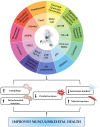Which Approach to Choose to Counteract Musculoskeletal Aging? A Comprehensive Review on the Multiple Effects of Exercise
- PMID: 40806700
- PMCID: PMC12347637
- DOI: 10.3390/ijms26157573
Which Approach to Choose to Counteract Musculoskeletal Aging? A Comprehensive Review on the Multiple Effects of Exercise
Abstract
Aging is a complex physiological process that profoundly affects the functionality of the musculoskeletal system, contributing to an increase in the incidence of diseases such as osteoporosis, osteoarthritis, and sarcopenia. Cellular senescence plays a crucial role in these degenerative processes, promoting chronic inflammation and tissue dysfunction through the senescence-associated secretory phenotype (SASP). Recently, senotherapeutics have shown promising results in improving musculoskeletal health. Natural compounds such as resveratrol, rapamycin, quercetin, curcumin, vitamin E, genistein, fisetin, and epicatechin act on key signaling pathways, offering protective effects against musculoskeletal decline. On the other hand, molecules such as dasatinib, navitoclax, UBX0101, panobinostat, and metformin have been shown to be effective in eliminating or modulating senescent cells. However, understanding the mechanisms of action, long-term safety, and bioavailability remain areas for further investigation. In this context, physical exercise emerges as an effective non-pharmacological countermeasure, capable of directly modulating cellular senescence and promoting tissue regeneration, representing an integrated strategy to combat age-related diseases. Therefore, we have provided an overview of the main anti-aging compounds and examined the potential of physical exercise as a strategy in the management of age-related musculoskeletal disorders. Further studies should focus on identifying synergistic combinations of pharmacological and non-pharmacological interventions to optimize the effectiveness of anti-aging strategies and promoting healthier musculoskeletal aging.
Keywords: aging; musculoskeletal system; physical exercise; physiology; prevention; senescence; senotherapeutic.
Conflict of interest statement
The authors declare no conflicts of interest.
Figures



Similar articles
-
Prescription of Controlled Substances: Benefits and Risks.2025 Jul 6. In: StatPearls [Internet]. Treasure Island (FL): StatPearls Publishing; 2025 Jan–. 2025 Jul 6. In: StatPearls [Internet]. Treasure Island (FL): StatPearls Publishing; 2025 Jan–. PMID: 30726003 Free Books & Documents.
-
Global consensus on optimal exercise recommendations for enhancing healthy longevity in older adults (ICFSR).J Nutr Health Aging. 2025 Jan;29(1):100401. doi: 10.1016/j.jnha.2024.100401. Epub 2025 Jan 1. J Nutr Health Aging. 2025. PMID: 39743381 Free PMC article. Review.
-
Senotherapeutics: Milestones, innovations, and future prospects.Adv Pharmacol. 2025;104:1-35. doi: 10.1016/bs.apha.2025.01.021. Epub 2025 Mar 3. Adv Pharmacol. 2025. PMID: 40716927 Review.
-
Targeting Senescence: A Review of Senolytics and Senomorphics in Anti-Aging Interventions.Biomolecules. 2025 Jun 13;15(6):860. doi: 10.3390/biom15060860. Biomolecules. 2025. PMID: 40563501 Free PMC article. Review.
-
Cellular senescence and senotherapeutics in cardiovascular diseases.Adv Pharmacol. 2025;104:313-349. doi: 10.1016/bs.apha.2025.01.019. Epub 2025 Feb 24. Adv Pharmacol. 2025. PMID: 40716934 Review.
References
-
- Cariati I., Scimeca M., Bonanni R., Triolo R., Naldi V., Toro G., Marini M., Tancredi V., Iundusi R., Gasbarra E., et al. Role of Myostatin in Muscle Degeneration by Random Positioning Machine Exposure: An in Vitro Study for the Treatment of Sarcopenia. Front. Physiol. 2022;13:782000. doi: 10.3389/fphys.2022.782000. - DOI - PMC - PubMed
-
- Tarantino U., Cariati I., Greggi C., Iundusi R., Gasbarra E., Iolascon G., Kurth A., Akesson K.E., Bouxsein M., Tranquilli Leali P., et al. Gaps and Alternative Surgical and Non-Surgical Approaches in the Bone Fragility Management: An Updated Review. Osteoporos. Int. 2022;33:2467–2478. doi: 10.1007/s00198-022-06482-z. - DOI - PubMed
Publication types
MeSH terms
Substances
LinkOut - more resources
Full Text Sources
Medical

